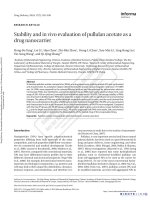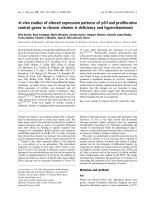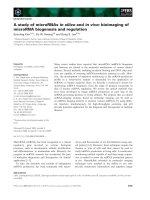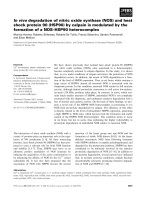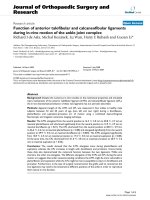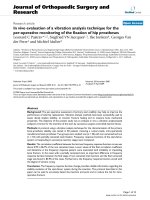In vitro and in vivo evaluation of transferrin conjugated lipid shell and polymer core nanoparticles for targeted delivery of docetaxel
Bạn đang xem bản rút gọn của tài liệu. Xem và tải ngay bản đầy đủ của tài liệu tại đây (2.13 MB, 129 trang )
IN VITRO AND IN VIVO EVALUATION OF TRANSFERRIN-CONJUGATED
LIPID SHELL AND POLYMER CORE NANOPARTICLES FOR TARGETED
DELIVERY OF DOCETAXEL
PHYO WAI MIN
NATIONAL UNIVERSITY OF SINGAPORE
2011
IN VITRO AND IN VIVO EVALUATION OF TRANSFERRIN-CONJUGATED
LIPID SHELL AND POLYMER CORE NANOPARTICLES FOR TARGETED
DELIVERY OF DOCETAXEL
PHYO WAI MIN
(M.B.,B.S (YGN) U.M(1))
A THESIS SUBMITTED
FOR THE DEGREE OF MASTER OF ENGINEERING
DEPARTMENT OF CHEMICAL AND BIOMOLECULAR ENGINEERING
NATIONAL UNIVERSITY OF SINGAPORE
2011
Acknowledgements
First of all, I would like to express my profound gratitude to my supervisor, Professor
Feng Si Shen, for his support, encouragement and guidance throughout my M.Eng
study.
Sincere appreciation is also expressed to all the professional lab officers and lab
technologists, Mr Chia Phai Ann, Dr. Yuan Ze Liang, Mr. Boey Kok Hong, Ms.
Samantha Fam, Mdm. Li Fengmei, Ms. Lee Chai Keng, Ms Li Xiang and Ms. Dinah
Tan, for their technical assistance and administrative works.
I am also grateful to all my colleagues, Dr. Sun Bingfeng, Mr. Li Yutao, Mr. Prashant,
Dr. Shena Kulkarni, Mr. Gan Chee Wee, Ms Chaw Su Yin, Mr Tan Yang Fei, Mr Mi
Yu, Ms Zhao Jing, Mr Annandh and Dr Mutu, for their support and advices.
i
TABLE OF CONTENTS
ACKNOWLEDGEMENTS
i
TABLE OF CONTENTS
ii
SUMMARY
vii
NOMENCLATURE
viii
LIST OF TABLES
x
LIST OF FIGURES
xi
CHAPTER 1: INTRODUCTION
1
1.1 General Background
1
1.2 Objectives and Thesis Organization
3
CHAPTER 2: LITERATURE REVIEW
2.1 Cancer and cancer chemotherapy
5
5
2.1.1 Treatments of cancer
5
2.1.2 Anticancer drugs
6
2.1.2.1 Doxcetal
8
2.1.3 Limitations of traditional chemotherapy
12
2.1.4 Anatomical, physiological and pathological considerations
14
2.1.5 Tumor Targeting
16
2.1.5.1 Passive targeting
17
2.1.5.2 Active targeting
19
2.2 Alternatives of Drug Formulations
23
2.2.1 Liposmes
23
2.2.2 Polymeric Micells
25
2.2.3 Prodrugs
28
ii
2.2.4 Polymeric nanoparticles
31
2.3 Fabrication Methods of Nanoparticles
32
2.3.1 Emulsion/Solvent Evaporation
33
2.3.2 Solvent Displacement
35
2.3.3 Salting Out
36
2.3.4 Supercritical (SCF) Technology
37
2.4 Lipid Shell and Polymer Core Nanoparticles (LPNPs)
38
2.5 Transferrin/Transferrin Receptor-Mediated Drug Delivery
40
2.5.1 Properties and Biological Function of Transferrin
41
2.5.2 Structure and Function of Transferrin Receptors
42
CHAPTER 3: SYNTHESIS AND CHARACTERIZATION OF LIPID SHELL
44
AND POLYMER CORE NANOPARTICLES
3.1 Introduction
44
3.2 Materials
45
3.3 Methods
45
3.3.1 Preparation of Lipid Shell and Polymer Core Nanoparticles
45
(LPNPs)
3.3.2 Characterization of LPNPs
46
3.3.2.1 Particle Size Analysis
46
3.3.2.2 Surface Morphology
46
3.3.2.3 Surface Charge
47
3.3.2.4 Surface Chemistry
47
3.3.2.5 Drug Encapsulation Efficiency
47
3.3.3 Results and Discussions
3.3.3.1 Particle Size and Size Distribution
48
48
iii
3.3.3.2 Surface Morphology
49
3.3.3.3 Surface Charge
51
3.3.3.4 Surface Chemistry
51
3.3.3.5 Drug Encapsulation Efficiency
52
3.4 Conclusions
CHAPTER 4: SYNTHESIS AND CHARACTERIZATION OF TRANSFERRIN
52
53
CONJUGATED LIPID SHELL AND POLYMER CORE NANOPARTICLES
4.1 Introduction
53
4.2 Materials
54
4.3 Methods
54
4.3.1 Synthesis of DSPE-PEG-NH2
54
4.3.2 Preparation of Transferrin Conjugated LPNPs
55
4.3.3 Characterization of DSPE-PEG-NH2
56
4.3.3.1 1H Nuclear Magnetic Resonance (NMR) Spectroscopy
4.3.4 Characterization of Transferrin Conjugated LPNPs
56
56
4.3.4.1 Particle Size Analysis
56
4.3.4.2 Surface Morphology
56
4.3.4.3 Surface Charge
56
4.3.4.4 Surface Chemistry
57
4.3.4.5 Drug Encapsulation Efficiency
57
4.3.4.6 In Vitro Drug Release
58
4.4 Results and Discussions
4.4.1 Characterization of DSPE-PEG-NH2
4.4.1.1 1H Nuclear Magnetic Resonance (NMR) Spectroscopy
4.4.2 Particle Size and Size Distribution
58
58
58
60
iv
4.4.3 Surface Morphology
60
4.4.4 Surface Charge
61
4.4.5 Surface Chemistry
61
4.4.6 Drug Encapsulation Efficiency
62
4.4.7 In Vitro Drug Release
62
4.5 Conclusions
CHAPTER 5: IN VITRO CELLULAR STUDY OF TRANSFERRIN
63
65
CONJUGATED LPNPs
5.1 Introduction
65
5.2 Materials
66
5.3 Methods
66
5.3.1 Cell Culture
66
5.3.2 In Vitro Cellular Uptake
66
5.3.3 In Vitro Cell Cytotoxicity
68
5.4 Results and Discussions
68
5.4.1 In Vitro Cell Uptake
68
5.4.2 In Vitro Cell Cytotoxicity
71
5.5 Conclusions
CHAPTER 6: IN VIVO PHARMACOKINETICS, COMPLETE BLOOD
73
74
COUNT AND BLOOD BIOCHEMISTRY STUDY
6.1 Introduction
74
6.2 Materials and Methods
75
6.2.1 In Vivo Pharmacokinetics
75
6.2.2 Histopathological evaluation
76
6.2.3 Complete Blood Count
76
v
6.2.4 Blood Biochemistry Study
6.3 Results and Discussions
76
77
6.3.1 In Vivo Pharmacokinetics
77
6.3.2 Complete Blood Count
79
6.3.3 Blood Biochemistry Study
80
6.3.4 Hispathological evaluation
82
6.4 Conclusions
CHAPTER 7: CONCLUSIONS AND RECOMMENDATIONS
82
84
7.1 Conculsions
84
7.2 Recommendations
85
BIBLIOGRAPHY
86
vi
Summary
The primary goal of novel anticancer drug design is to selectively target and kill the
cancer cells, improving therapeutic efficacy while minimizing side effects. Lipid shell
and polymer core drug delivery systems have received increasing attention due to the
combinations of merits from liposomes and polymeric nanoparticles. In this work, the
effects of different lipids used in nanoparticle preparation on their characteristics and
in vitro performance were studied. Nanoparticles of PLGA as the core and various
lipids as the shell were produced by nanoprecipitation method. Transferrin was used as
the targeting ligand. Series of characterization of the nanoparticles were carried out by
laser light scattering (LLS) for particle size and size distribution, zeta potential
analyzer for surface charge and field emission scanning electron microscopy (FESEM)
for surface morphology. The presence of lipid layer on the surface of nanoparticles
was confirmed by X-ray photoelectron spectroscopy (XPS). The structure of lipid shell
and polymer core was visualized by transmission electron microscopy (TEM). The
drug encapsulation efficiency (EE) of the docetaxel-loaded nanoparticles was
measured by high performance liquid chromatography (HPLC). The size, surface
charge and EE of the nanoparticles were found to be correlated to the lipid type and
quantity. Moreover, in vivo pharmacokinetics study, complete blood count analysis
and toxicity assessment through haematology assay and histological analysis of
clearance organs were carried out in order to demonstrate the prospect of the
formulation as drug delivery system.
vii
NOMENCLATURE
ACN
acetonitrile
AUC
area under concentration-time curve
BD
biodistribution
Cmax
peak concentration
CLSM
confocal laser scanning microscopy
CMC
critical micelle concentration
CYP
cytochrome P450
DCM
dichloromethane
DMEM
Dulbecco‘s Modified Eagle Medium
DSPE
distearoylphosphatidylethanolamine
DSPE-PEG2k 1,2-distearoyl-snglycero- 3phospothanolamine-N[methoxy(polyethylene glycol)-2000]
EE
encapsulation efficiency
EPR
enhanced permeability and retention
FBS
fetal bovine serum
FESEM
field emission scanning electron microscopy
HIV
human immunodeficiency virus
HLB
hydrophile-lipophile balance
1
proton nuclear magnetic resonance
H NMR
HPLC
high performance liquid chromatography
HPMA
N-(2-hydroxypropyl)methacrylamide
IC50
inhibitory concentration at which 50% cell population is suppressed
LLS
laser light scattering
MRT
mean residence time
MTT
3-(4,5--2-yl)-2,5-diphenyltetrazolium bromide Dimethylthiazol
MPS
mononuclear phagocyte system
viii
NP
nanoparticle
NSCLC
non-small-cell lung cancers
PBS
phosphate buffer saline
PC
phosphatidylcholine
PCL
poly(caprolactone)
PDI
polydispersity index
PEG
polyethylene glycol
P-gp
P-glycoprotein
PI
propidium iodide
PLA
poly(lactide)
PLGA
poly(d,l-lactide-co-glycolide)
PVA
polyvinyl alcohol
RES
reticuloendothelial system
RESS
rapid expansion from supercritical solution
SD
Sprague-Dawley
T1/2
half-life
THF
tetrahydrofuran
TPGS
d-α-tocopheryl polyethylene glycol 1000 succinate
Tween 80
polyoxyethylene-20-sorbitan monooleate (or polysorbate 80)
XPS
x-ray photoelectron spectroscopy
ix
LIST OF TABLES
Table 1: Size, polydispersity, zeta potential
and drug encapsulation
49
efficiency of docetaxel-loaded lipid shell and polymer core
nanoparticles
Table 2: Size, polydispersity and zeta potential of docetaxel-loaded
60
PLGA/50-50 NPs and PLGA/50-50 Tf NPs
Table 3: IC50 of MCF7 cells after 24 and 48 h incubation with docetaxel
72
formulated in PLGA/50-50 NPs formulation, PLGA/50-50 Tf
NPs formulation and Taxotere® at various drug concentrations.
Table 4: Mean non-compartmental pharmacokinetic parameters of SD
78
rats for intravenous administration of Taxotere® and PLGA/5050 NPs at a dose of 7.5 mg/kg
Table 5: Complete
blood
count
for
SD
rats
after
intravenous
79
administration of Taxotere® and PLGA/50-50 NPs at a dose of
7.5 mg/kg, and for rats receiving no injection (as control)
Table 6: Serum chemistry for SD rats after intravenous administration of
81
Taxotere® and PLGA/50-50 NPs at a dose of 7.5 mg/kg, and for
rats receiving no injection (as control)
x
LIST OF FIGURES
Figure 1:
Chemical structure of docetaxel (Montero et al., 2005)
8
Figure 2:
Figure of Taxotere®
9
Figure 3:
Effect of docetaxel on microtubule function (Montero et al.,
11
2005)
Figure 4:
The chemical structure of Cremophor EL (Gelderblom et al.,
13
2001).
Figure 5:
Differences between normal and tumor tissues that show the
16
passive targeting of nanocarriers by the EPR effect.
Figure 6:
Visualization of extravasation of PEG-liposomes.
17
Figure 7:
A. Passive targeting of nanocarriers.
18
Figure 8:
Main classes of ligand-targeted therapeutics.
20
Figure 9:
Liposomes can vary in size between 50 and 1000 nm.
24
Figure 10:
A micelle as it self-assembles in the aqueous medium from
26
amphiphilic
unimers
(such
as
polyethylene
glycol–
phosphatidylethanolamine conjugate, PEG–PE; see on the top)
with the hydrophobic core
Figure 11:
A simplified representative illustration of the prodrug concept
28
Figure 12:
Capecitabine as an example of a prodrug that requires multiple
29
enzymatic activation steps ( Testa, B, 2004; Rautio et al, 2008)
Figure 13 :
Ringsdorf‘s model for a polymeric drug containing the drug,
30
solubilising groups, and targeting groups bound to a linear
polymer backbone (Kratz et al, 2008).
Figure 14:
Principle types of nanocarriers for drug delivery. (A)
Liposomes,
(B)
Polymeric
nanospheres,
(C)
31
Polymeric
nanocapsules, (D) Polymeric micelles (Hillaireau and Couvreur
xi
2009)
Figure 15:
Schematic representation of the emulsion/solvent evaporation
34
technique (Pinto Reis et al, 2006).
Figure 16:
Schematic
representation
of
the
solvent
displacement
35
technique.**Surfactant is optional. ***For preparation of
nanocapsules. (adapted from Pinto Reis et al, 2006)
Figure 17:
Rapid expansion supercritical solution method (adapted from
37
Mishra et al, 2010).
Figure 18:
Supercritical antisolvent precipitation method (adapted from
38
Mishra et al, 2010).
Figure 19:
Schematic illustration of lipid–polymer hybrid nanoparticle
39
(adapted from Chan et al., 2009)
Figure 20:
X-ray crystal structure of human serum transferrin
41
(Li and Qian; 2002).
Figure 21:
X-ray crystal structure of the dimeric ectodomain of the human
42
transferrin receptor. (Li and Qian; 2002)
Figure 22:
Calibration curve of docetaxel
48
Figure 23:
FESEM images of docetaxel-loaded (A) PLGA/100-0 NPs, (B)
50
PLGA/75-25 NPs, (C) PLGA/50-50 NPs and (D) PLGA/25-75
NPs.
Figure 24:
Transmission electron microscopy (TEM) image demonstrated
50
PLGA/50-50 NPs which were stained with phospho tungstic
acid.
Figure 25:
X-ray photoelectron spectroscopy (XPS) peaks of the lipid shell
51
and polymer core nanoparticles (PLGA/50-50 NPs).
Figure 26:
1
H-NMR spectra of the DSPE, NH2-PEG-NH2 and DSPE-PEG-
59
NH2
xii
Figure.27:
FESEM images of docetaxel-loaded (A) PLGA/50-50 NPs and
60
(B) PLGA/50-50 Tf NPs.
Figure 28:
X-ray photoelectron spectroscopy (XPS) peaks of PLGA/50-50
61
NPs and PLGA/50-50 Tf NPs.
Figure 29:
In vitro drug release profiles of the PLGA/50-50 NPs and
62
PLGA/50-50 Tf NPs in pH 7.4 PBS buffer at 37 ˚C.
Figure.30:
Cellular uptake of coumarin 6-loaded PLGA/50-50 NPs and
69
PLGA/50-50 Tf NPs incubated with MCF7 breast cancer cells at
37 C for 2 h and 4 h.
Figure.31:
.Confocal laser scanning microscopic images of MCF7 breast
70
cancer cells after 2 h incubation with coumarin 6-loaded
nanoparticles.
Figure 32:
In vitro cell viablity test of docetaxel loaded PLGA/50-50 NPs,
®
PLGA/50-50 Tf NPs and Taxotere
71
incubated with MCF7
breast cancer cells at 37 C
Figure 33:
In vivo pharmacokinetics profiles of docetaxel plasma
78
®
concentration vs. time after i.v. administration of Taxotere and
the PLGA/50-50 NPs formulation using Sprague-Dawley rats at
the same docetaxel dose of 7.5 mg/kg (n=5).
Figure 34:
Representative H&E stained tissue sections of rat liver and
82
kidney
xiii
CHAPTER 1: INTRODUCTION
1.1 General Background
Cancer is one of the major devastating diseases. Currently available effective
treatments include surgery, radiotherapy, chemotherapy, hormone therapy and
immunotherapy, which are usually given in combinations (American Cancer Society,
2010). Among them, chemotherapy has become the most promising treatment option
with the help of advances in materials science and protein engineering. Novel
nanoscale drug delivery devices and targeting approaches which may bring new hope
to cancer patients are being extensively investigated (Peer et al. 2007). The primary
goal of novel anticancer drug design is to selectively target and kill the cancer cells,
improving therapeutic efficacy while minimizing the side effects (Moghimi et al.,
2005; Torchilin, 2010).
Currently used pharmaceutical nanocarriers, such as polymeric nanoparticles (NPs),
liposomes, micelles, and many others demonstrate a variety of useful properties,
including long circulation in the blood and controlled drug released profile (Ferrari,
2005). In the recent years, lipid shell and polymer core nanoparticles are gaining
interest as they are able to combine the merits of both liposomal and nanoparticulate
drug delivery systems (Chan et al., 2009; Salvador-Morales et al., 2009; Liu et al.,
2010). Doxil (Doxorubicin encapsulated liposome) was the first to get FDA approval
in 1995 for the treatment of Kaposi‘s sarcoma and ovarian cancer (Wagner et al, 1994;
Gottlieb et al, 1997; Salvador-Morales et al., 2009). Even though liposomes are highly
biocompatible and are able to provide favourable pharmacokinetic profile, they have
insufficient drug loading, faster drug release and storage instability. Meanwhile,
nanoparticles can provide high drug encapsulation efficiency for hydrophobic drugs
1
and controlled drug release profile (Salvador-Morales et al., 2009; Liu et al., 2010).
Therefore, lipid shell and polymer core nanoparticles with antitumor targeting would
be an ideal nanoscale drug delivery system for hydrophobic drugs such as docetaxel
and paclitaxel.
Biodegradable polymers such as poly(D,L-lactic acid) (PLA), poly(D,L-lactic-coglycolic acid) (PLGA) and poly(3-caprolactone) (PCL) and their co-polymers
diblocked or multiblocked with polyethylene glycol (PEG) have been commonly used
to synthesize nanoparticles to encapsulate a variety of therapeutic compounds (Feng,
2006). PEGylation, which refers to polyethylene glycol conjugated drugs or drug
carriers, is essential for drug delivery devices to enhance both the circulation time and
the stability (against enzyme attack or immunogenic recognition) (Davis, 2002;
Danhier et al., 2010). DSPE-PEG2k (N-(carbonyl -methoxypolyethylene glycol-2000) 1,2-distearoyl-sn-glycerol-3-phosphoethanolamine) , a lipid attached to PEG, is
usually used to coat the outer surface of the liposome in order to get the PEGylation
effects such as prolonged circulation half –life and reduced systemic clearance rate.
These PEG-end groups may also be functionalized with specific ligands to target the
specific sites of the cells, tissues and organs of interest (Chan et al., 2009; Liu et al.,
2010).
Generally, malignant cells grow and divide faster than normal cells. In order to grow
faster, they need to express more cell surface receptors for the transport of iron and
nutrients (Hémadi et al, 2004). Transferrin receptor is one of the cell surface receptors
and usually expressed more abundantly in malignant tissues than in normal tissues
because of the higher iron demand for faster cell growth and division of the malignant
cells (Vyas and Sihorkar , 2000; Li and Qian, 2002). Transferrin plays a pivotal role in
the transportation of iron for the synthesis of haemoglobin (Li and Qian, 2002). Based
2
on this fact, transferrin can be potentially utilized as a cell marker for tumour
detection. Therefore, transferrin–transferrin receptor interaction has been employed as
a potential efficient pathway for cellular uptake of drugs, genes and nanocarriers (Li
and Qian, 2002; Gomme, 2005).
Docetaxel is a semi-synthetic taxane and one of the most effective anticancer drugs
against a broad range of human malignancies (Montero et al., 2005). It is approved for
the treatment of patients with locally advanced or metastatic breast cancer or nonsmall-cell lung cancer (NSCLC) and androgen-independent metastatic prostate cancer
(Valero et al., 1995; Fossella et al., 2000; Petrylak, 2004). However, because of poor
solubility in water, docetaxel is formulated using Tween 80 (polysorbate 80) and
ethanol (50:50, v/v) (Clarke et al., 1999). Tween 80 is responsible for acute
hypersensitivity reactions which have been occurred in the majority of patients during
phase I clinical trials (Fossella et al, 2000; Coors et al, 2005). In the view of this
observation, there is a strong rationale for using nanocarrier to reformulate the
docetaxel without using Tween 80. Docetaxel formulation without using potentially
toxic adjuvant, Tween 80 (polysorbate 80), can be achieved by formulation of lipid
shell and polymer core nanoparticles. This formulation can further be modified by
conjugation with transferrin to achieve active targeting property.
1.2 Objectives and Thesis Organization
In this thesis, formulations of lipid shell and polymer core nanoparticles are developed
for the clinical administration of docetaxel. At the same time, the effect of different
lipids used in nanoparticle preparation on their characteristics and in vitro performance
is studied. Moreover, in vivo pharmacokinetic study, complete blood count analysis
and toxicity assessment through haematology assay and histological analysis of
3
clearance organs are carried out in order to demonstrate the prospects of the
formulation as drug delivery system.
The thesis is made up of seven chapters. The first chapter is to provide a brief
introduction including a general background and objectives of the project. In Chapter
2, a literature review on cancer and cancer chemotherapy, and the concept and
formulations of drug delivery system is provided. The strategies applied for targeted
drug delivery system is also clearly described in this chapter. Then, the synthesis and
characterization of lipid shell and polymer core nanoparticles (LPNPs) are discussed in
Chapter 3 while the synthesis and characterization of transferrin conjugated lipid shell
and polymer core nanoparticles are discussed in Chapter 4. In Chapter 5, in vitro
cellular study of transferrin conjugated LPNPs is performed using MCF7 human breast
adenocarcinoma cells. In Chapter 6, in vivo pharmacokinetics, complete blood count
and blood biochemistry study using Sprague-Dawley rats are investigated to compare
the LPNPs formulation and the commercial formulation (Taxotere®). Finally,
conclusions are drawn and recommendations for future work are provided in Chapter
7.
4
CHAPTER 2: LITERATURE REVIEW
2.1 Cancer and cancer chemotherapy
Cancer is a group of diseases caused by uncontrolled growth and spreading of
abnormal cells. It is the second most common cause of death in the United States,
following cardiovascular diseases. Currently, one in four deaths in the United States
and Europe is attributed to cancer (American Cancer Society, 2010; Albreht et al.,
2008). In fact, the emotional and physical suffering inflicted by cancer is more
agonizing than death. Fortunately, the silver lining is that the cancer mortality rate for
both male and female has declined in the United States during last two decades. It is
believed that external factors (e.g., tobacco smoking, chemicals, radiation, and
infectious organism) and internal factors (e.g., inherited mutations, hormones, and
immune conditions) may act together (or sequentially) to initiate and promote
carcinogenesis (Feng and Chien, 2003; American Cancer Society, 2010).
2.1.1 Treatments of cancer
Surgery, radiotherapy, chemotherapy, hormone therapy, biological therapy and
targeted therapy are usually employed as treatments for cancer. These treatment
modalities may be rendered alone or in combination, depending on the stage of cancer
and other factors. Surgery can be used to prevent, treat and diagnose cancer. The
objective of conducting surgery in cancer treatment is to remove tumours or as much
of the cancerous tissues as possible. For the more complicated cancer cases where
possible treatments may be limited, palliative surgeries may be rendered which aim at
improving the quality of life of the patients. On the other hand, chemotherapy, another
type of cancer treatment, uses drugs to eliminate rapidly multiplying cancer cells.
5
Unfortunately, besides eliminating the cancer cells, rapidly multiplying hair follicle
and stomach lining cells will also be affected, resulting in side effects like hair loss and
stomach upset. In radiation therapy, certain types of energy are utilized to shrink
tumours or eliminate cancer cells by damaging their DNA, stunting growth. Cancer
cells are sensitive to radiation and typically die when treated. However, surrounding
healthy cells can be affected as well. Fortunately, they are able to recover fully. Early
detection and treatment are critical factors in determining the patient‘s prognosis.
Therefore, regular screening examinations are becoming crucial in cancer prevention
and treatment. Although it is difficult to predict who is at risk of developing cancer, it
is undeniable that the incidence of cancer can be reduced by undergoing regular cancer
screening, controlling tobacco smoking, alcohol usage, obesity and sun exposure, and
having appropriate nutrition and physical activity (American Cancer Society, 2010).
2.1.2 Anticancer drugs
Chemotherapy is defined as the use of any medicine for treatment of any disease.
Chemotherapy for cancer, however, is described as the use of chemotherapeutical
agents to kill or control cancer cells. The combination of chemotherapy with other
treatments has become the primary and standard treatments for cancers, as well as for
other diseases caused by uncontrolled cell growth and invasion of foreign cells or
viruses (Feng and Chien, 2003).
Cancer chemotherapy was discovered by chance. During the 2nd World War, the US
navy was exposed to nitrogen mustard gas accidentally. The alkylating agent was
found to cause reduction in cell number of the bone marrow and lymphoid tissues.
This agent was adapted for the clinical treatment of advanced lymphomas in 1943
(Bishop, 1999). Over the following years, there have been hundreds of anticancer
6
agents available for clinical use; some are synthetic chemicals and some are natural
extracts. Chemotherapeutic agents can be divided into few groups according to their
mechanisms of action. Some of them are antimetabolites, alkylating agents, antimitotic
agents and anthracyclines.
Methotrexate is one of the most widely used antimetabolites that competitively inhibits
dihydrofolate reductase (DHFR) which converts dihydrogenfolate (DHF) to
tetrahydrofolate (THF). This prohibits the synthesis of folic acid, pyrimidine or purine
for DNA/RNA. Methotrexate is a S-phase specific anticancer agent (Allegra et.al.,
1985; Blakley et.al., 1998). Cyclophosphamide is a nitrogen mustard alkylating agent
which covalently bond with DNA, inhibiting DNA replication and transcription. It is a
prodrug which will transform to its active form in the liver. It is used in the treatment
of a wide range of cancers including Hodgkin‘s disease, non-Hodgkin‘s lymphoma,
various types of leukemia, multiple myeloma, neuroblastomas, adenocarcinomas of the
ovary, and certain malignant neoplasms of the lung. Antimitotic (anti-microtubular)
agents include the naturally occurring vinca alkaloids (e.g. vincristine and vinblastine)
and their semi-synthetic analogues (e.g. vinorelbine) and the taxanes (e.g. paclitaxel
and docetaxol). They act on the microtubules, an essential part of the cytoskeleton of
eukaryotic cells. The vinca alkaloids prevent the protein from polymerizing into
microtubules by binding specifically to β-tubulin. In contrast, the taxanes prevent the
microtubules from depolymerisation by binding to the β-tubulin subunits of the
microtubules during the mitotic phase (Cutts, 1961; Kruczynski et al., 1998). The
anthracyclines (eg. doxorubicin) are regarded as essential agents in combination
chemotherapeutic regimens and have been successfully used in the first and secondline treatments of metastatic diseases. The major mechanism contributing to their
cytotoxicity against tumors remains unclear. However, it is widely acknowledged that
7
these compounds intercalate with DNA, thereby preventing DNA and RNA synthesis
(Fornari et al., 1994).
2.1.2.1 Docetaxel
Docetaxel is an antineoplastic agent belonging to the taxoid family. It is a semisynthetic product made from extracts of the renewable needle biomass of yew plants.
The chemical name for docetaxel is (2R,3S)-N-carboxy-3-phenylisoserine,N-tertbutyl;-20-epoxy-1,2α,4,7β,10b,13α-hexahydroxytax-11-en-9-one4-acetate 2-benzoate,
trihydrate. Docetaxel has the following structural formula (Montero et al., 2005):
Figure 1: Chemical structure of docetaxel (Montero et al., 2005)
Docetaxel is a white to almost white powder and is practically insoluble in water. The
diluent for the clinical formulation contains 13% ethanol. The commercial product of
docetaxel, Taxotere®, is developed by the pharmaceutical company Sanofi-Aventis.
Taxotere® is available as 20 mg and 80 mg single-dose vials of concentrated
anhydrous docetaxel in polysorbate 80 (Clarke et al., 1999). The figure of Taxotere® is
shown in Figure 2. The prepared solution is a clear brown-yellow colour which
contains 40 mg docetaxel per mL of polysorbate 80 (Clarke et al., 1999). This high
8
concentration solution is to be diluted with 0.9% sodium chloride or 5% glucose before
administration (Clarke et al., 1999).
Figure 2: Figure of Taxotere®
Pharmacokinetics
Oral bioavailability of docetaxel is around 8 % as docetaxel is a substrate for pglycoprotein (Sparreboom, 1996; Malingre et al., 2001). Moreover, first-pass
elimination by cytochrome P450 (CYP) isoenzymes in the liver and/or gut wall may
also attribute to the low oral bioavailability of docetaxel (CYP 3A4) (Shou et al., 1998;
Malingre et al., 2001).
However, when docetaxel is co-administered with
cyclosporine, bioavailability increased up to 90% which is almost comparable with
intravenous (IV) administration of docetaxel. But, in practice, docetaxel is usually
given intravenously as IV administration. In doing so, bioavailability is boosted to
100%, making it better and more helpful to achieve dose precision (Clarke et al.,
1999). In order to evaluate the pharmacokinetics profile, 100 mg/m2 dosages of
docetaxel is given over one-hour infusions every three weeks in phase II and III
clinical studies (Clarke et al., 1999).
Docetaxel was shown to have 94-97 % plasma protein binding after IV administration
(Extra et al., 1993). Docetaxel is mainly bound to alpha 1 acid glycoprotein,
lipoproteins, and albumin. Among them, alpha 1 acid glycoprotein is the main
9
determinant of docetaxel's plasma binding variability. Docetaxel was unaffected by the
polysorbate 80 which is used in its storage medium. Docetaxel interacted little with
erythrocytes (Urien et al., 1996; Clarke et al., 1999).
For the concentration-time profile of docetaxel, a n initial relatively rapid decline α
half-life is observed after about 4.5 minutes while β half-life and γ half-life are
observed after 38.3 minutes and 12.2 hours respectively. The initial rapid decline of α
half-life is caused by distributed to peripheral compartments and β half-life and γ halflife are the result of slow efflux of docetaxel from these compartments (Pazdur et al.,
1993; Clarke et al., 1999). The mean total body clearance of docetaxel is 21 L/h/m2 for
the administration of 100 mg/m² dosage over a one hour infusion and the Cmax of
docetaxel was around 4.15 ± 1.35 mg/L (Pazdur et al., 1993; Clarke et al., 1999; Baker
et al., 2004).
Moreover, it was also found that docetaxel demonstrated a linear
pharmacokinetics profile which implied that an increased dosage of docetaxel would
result in a linear increase of the area under concentration-time curve (AUC) and peak
concentration (Cmax) (Bissery et al., 1991; Gligorov and Lotz, 2004; McGrogan et al.,
2008). Hence, the dose of docetaxel used is directly proportional to plasma
concentration and it can be used to predict the various determinants of
pharmacokinetics profile when used together with different dosage regimes. Docetaxel
is eliminated in both the urine and faeces (Pazdur et al., 1993; Marlard et al., 1993).
Pharmacodynamics
Like other taxanes, docetaxel stabilises structures which contains microtubule, causing
cytotoxic effects in rapidly dividing cells, particularly during mitosis (Diaz and
Andreu, 1993; Montero et al., 2005). Docetaxel binds to microtubules reversibly with
high affinity and this binding stabilises microtubules and prevents depolymerisation at
10
